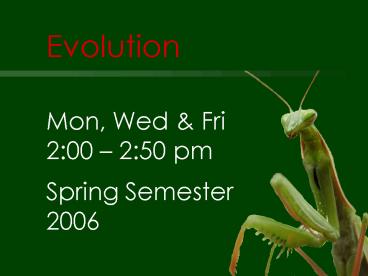Evolution PowerPoint PPT Presentation
1 / 19
Title: Evolution
1
Evolution Mon, Wed Fri 200 250
pm Spring Semester 2006
2
Evolution 1 2006 Spring
Evolutionary Mechanisms
3
Evolution 2 2006 Spring
Mechanisms
Charles Darwin -gt small inherited chances
provide continuous variation on which
natural selection acts Francis Galton (Darwins
cousin) -gt evolution must have proceeded in
sharp, discontinuous steps
4
Evolution 3 2006 Spring
Two schools
End of the 19th century. Selectionists versus
Mutationists continuous discontinuous variatio
n variation small differences are the large
mutations produce primary source for races
and species evolutionary change
5
Evolution 4 2006 Spring
Mutationists vs. Selectionists
Who is right?
6
Evolution 5 2006 Spring
Mutationists vs. Selectionists
Gap remained until 1920s and 1930s -gt
experimental work on quantitative characters
(Niellson-Ehle and East) -gt number of genes can
affect a single trait -gt provides wide variety
of geno- and phenotypes
7
Evolution 6 2006 Spring
Mutationists vs. Selectionists
3 genes determine wheat color -gt each gene pair
assorts independently -gt no dominance,
but intermediate colors gt continuous trait
8
Evolution 7 2006 Spring
Mutationists vs. Selectionists
Both small and large mutations play an important
role in natural selection
9
Evolution 8 2006 Spring
Mutationists vs. Selectionists
Genes can cause considerable morphological
differences -gt cultivation of maize -gt changes
in about 5 genes are responsible
10
Evolution 9 2006 Spring
Mutationists vs. Selectionists
Some mutations cause major phenotypic
changes. -gt these alone do not create new
species
11
Evolution 10 2006 Spring
The Neo-Darwinian Synthesis
A new concept gt Populations rather than
individuals are in the evolutionary
focus! gt Attention on population gene
frequencies gt Gene pool collection of gametes
given to the next generation
offspring draw genotypic variation randomly
12
Evolution 11 2006 Spring
The Neo-Darwinian Synthesis
The Hardy-Weinberg equilibrium
13
Evolution 12 2006 Spring
Hardy-Weinberg equilibrium
- Hardy-Weinberg equilibrium
- shuffling of genes during
- sexual reproduction does
- not alter the proportions of
- different alleles
- in a gene pool
Webbing
No webbing
14
Evolution 13 2006 Spring
Hardy-Weinberg equilibrium
Phenotypes
We can follow alleles in a population to
observe if Hardy-Weinberg equilibrium exists
Genotypes
WW
Ww
ww
Number of animals(total 500)
320
160
20
Genotype frequencies
20/500 0.04
320/500 0.64
160/500 0.32
Number of allelesin gene pool(total 1,000)
640 W
160 W 160 w
40 w
800/1,000 0.8 W
200/1,000 0.2 w
Allele frequencies
15
Evolution 14 2006 Spring
Hardy-Weinberg equilibrium
Recombinationof alleles fromheterozygote
parent generation
W sperm p 0.8
W egg p 0.8
SPERM
EGGS
WW p2 0.64
w sperm q 0.2
w egg q 0.2
WW qp 0.16
Ww pq 0.16
ww q2 0.04
Next generation
Genotype frequencies
0.64 WW
0.32 Ww
0.04 ww
Allele frequencies
0.8 W
0.2 w
16
Evolution 15 2006 Spring
Hardy-Weinberg equilibrium
- is a model, ? reality
- Five conditions must be met if genetic
equilibrium is to be maintained - 1) The population is very large
- 2) The population is isolated
- 3) Mutations do not alter the gene pool
- 4) Mating is random
- 5) All individuals are equal in reproductive
success - gt rarely happens
- Gene flow changes populations gradually
17
Evolution 15a 2006 Spring
Hardy-Weinberg equilibrium
18
Evolution 16 2006 Spring
The Neo-Darwinian Synthesis
-gt populations change -gt populations live in a
changing environment and adapt to
it Population genetics (Fisher) study of
gene frequencies and their change
19
Evolution 17 2006 Spring
The Neo-Darwinian Synthesis
Population genetics -gt the population has the
variability necessary to explain
evolutionary genetic change through time and
space -gt individuals do not gt Populations
evolve, individuals do not!

